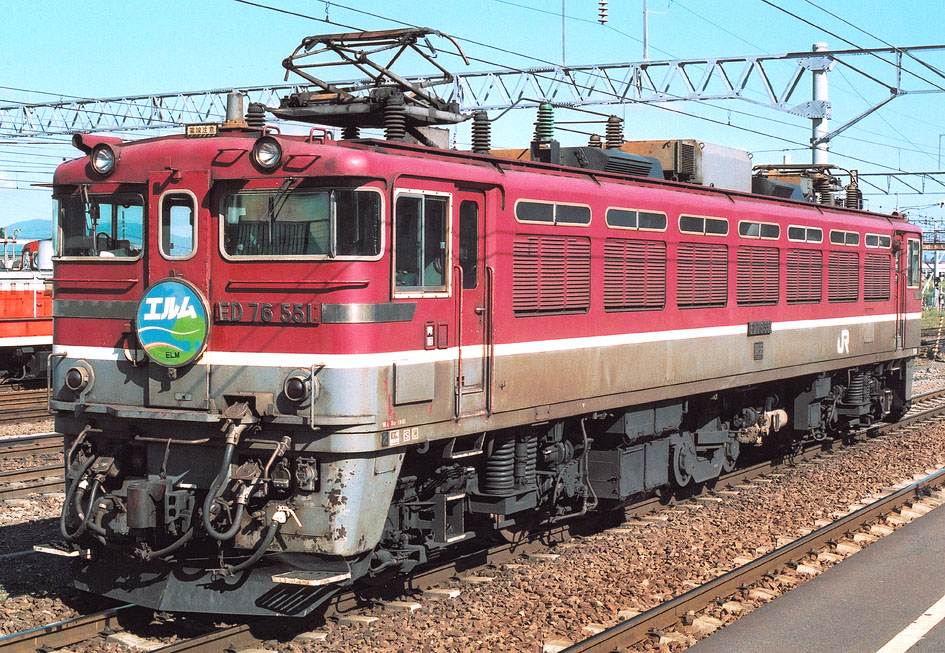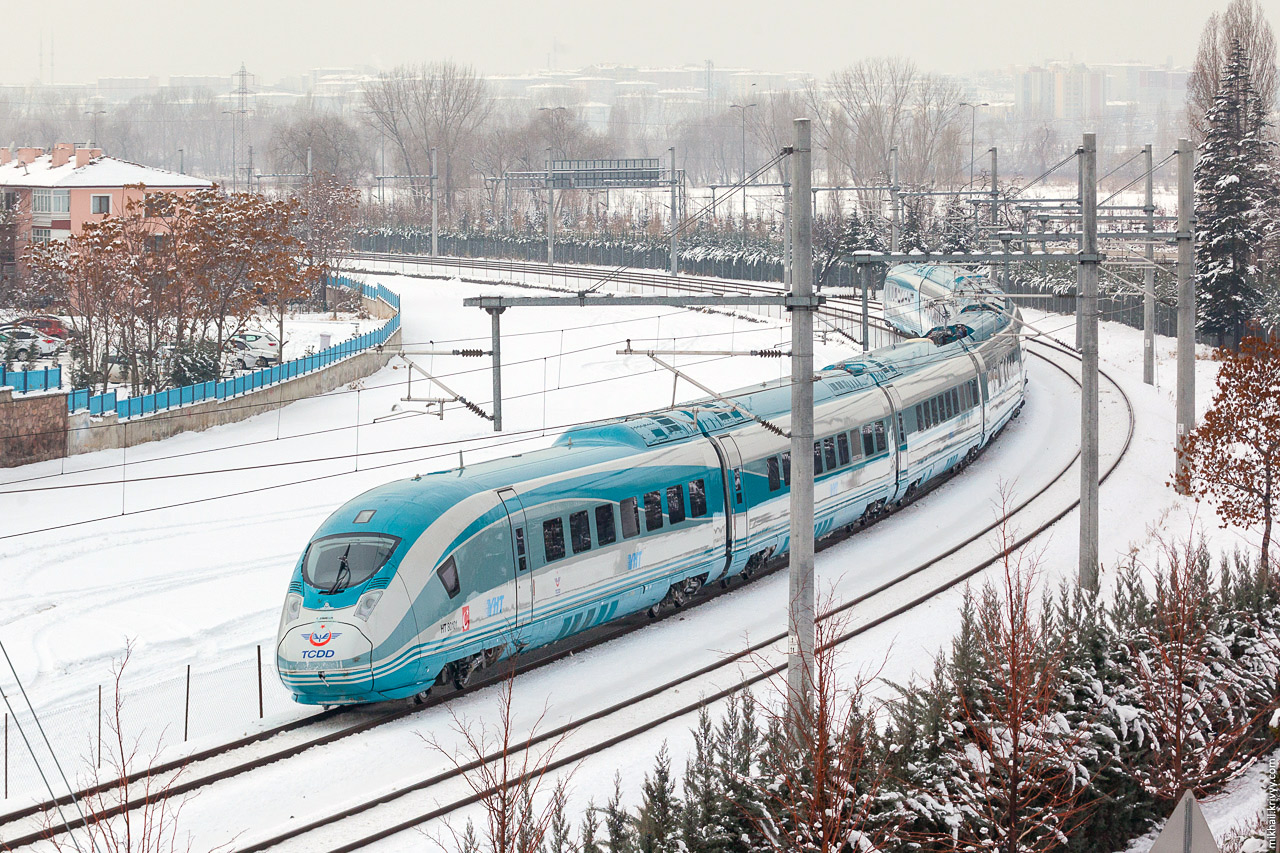|
TCDD DE11000
TCDD DE11000 is a series of diesel-electric locomotives used by the Turkish State Railways. The batch consisted of 85 units delivered from 1985. The first 20 locomotives were built by Krauss-Maffei, the remaining 70 on licence by Tülomsaş. There are two series of the locomotive, the first 15 having direct current motors, the latter 70 having alternating current motors. The units have Bo'Bo' B-B and Bo-Bo are the Association of American Railroads (AAR) and British classifications of wheel arrangement for railway locomotives with four axles in two individual bogies. They are equivalent to the B′B′ and Bo′Bo′ classifications in ... wheel arrangement and are powered by 720 kW engines (depending on model) Most of these are scrapped, some of these were converted to diesel-hydraulic traction, remaining ones are working in yard duties. It is possible to switch between either control stand of the cab even while moving. References External links Tülomsaş on DE11000Tr ... [...More Info...] [...Related Items...] OR: [Wikipedia] [Google] [Baidu] |
Diesel-electric Locomotive
A diesel locomotive is a type of railway locomotive in which the prime mover (locomotive), prime mover is a diesel engine. Several types of diesel locomotives have been developed, differing mainly in the means by which mechanical power is conveyed to the driving wheels. Early internal combustion engine, internal combustion locomotives and railcars used kerosene and gasoline as their fuel. Rudolf Diesel patented his first compression-ignition engine in 1898, and steady improvements to the design of diesel engines reduced their physical size and improved their power-to-weight ratios to a point where one could be mounted in a locomotive. Internal combustion engines only operate efficiently within a limited power band, and while low power gasoline engines could be coupled to mechanical transmission (mechanics), transmissions, the more powerful diesel engines required the development of new forms of transmission. This is because clutches would need to be very large at these power le ... [...More Info...] [...Related Items...] OR: [Wikipedia] [Google] [Baidu] |
Turkish State Railways Diesel Locomotives
Turkish may refer to: *a Turkic language spoken by the Turks * of or about Turkey ** Turkish language *** Turkish alphabet ** Turkish people, a Turkic ethnic group and nation *** Turkish citizen, a citizen of Turkey *** Turkish communities and minorities in the former Ottoman Empire * Ottoman Empire (Ottoman Turkey), 1299–1922, previously sometimes known as the Turkish Empire ** Ottoman Turkish, the Turkish language used in the Ottoman Empire * Turkish Airlines, an airline * Turkish music (style), a musical style of European composers of the Classical music era See also * * * Turk (other) * Turki (other) * Turkic (other) * Turkey (other) * Turkiye (other) * Turkish Bath (other) * Turkish population, the number of ethnic Turkish people in the world * Culture of Turkey * History of Turkey ** History of the Republic of Turkey The Republic of Turkey was created after the overthrow of Sultan Mehmet VI Vahdettin by the n ... [...More Info...] [...Related Items...] OR: [Wikipedia] [Google] [Baidu] |
Krauss-Maffei Locomotives
KraussMaffei is a German manufacturer of injection molding machines, machines for plastics extrusion technology, and reaction process machinery. It was acquired by ChemChina in 2016. History Locomotives KraussMaffei was formed in 1931 from a merger of the two Munich firms of Maffei (founded 1838) and Krauss & Co. (founded 1860). Both belonged to the leading German makers of locomotives of various types. Maffei also built other steam-operated vehicles and, later, manufactured vehicles with combustion engines, including locomotives, trolleybuses and buses until the 1950s. The headquarters of the firm remained in Munich. In the 1960s, KraussMaffei built several examples of the ML 4000 C′C′ diesel-hydraulic locomotive for demonstration and testing on American railroads. Southern Pacific and Denver & Rio Grande Western Railroad participated in the tests, but both found the locomotives unsuitable for service in the rugged Rocky Mountains through which the two railroads ran. I ... [...More Info...] [...Related Items...] OR: [Wikipedia] [Google] [Baidu] |
Bo-Bo Locomotives
B-B and Bo-Bo are the Association of American Railroads (AAR) and British classifications of wheel arrangement for railway locomotives with four axles in two individual bogies. They are equivalent to the B′B′ and Bo′Bo′ classifications in the UIC system. The arrangement of two, two-axled, bogies is a common wheel arrangement for modern electric and diesel locomotives. Bo-Bo Bo-Bo is the UIC indication of a wheel arrangement for railway vehicles with four axles in two individual bogies, all driven by their own traction motors. It is a common wheel arrangement for modern electric and diesel-electric locomotives, as well as power cars in electric multiple units. Most early electric locomotives shared commonalities with the steam engines of their time. These features included side rods and frame mounted driving axles with leading and trailing axles. The long rigid wheelbase and the leading and trailing axles reduced cornering stability and increased weight. The Bo-Bo c ... [...More Info...] [...Related Items...] OR: [Wikipedia] [Google] [Baidu] |
TCDD DH9500
TCDD DH9500 is a diesel-hydraulic locomotive operated by the Turkish State Railways (TCDD). A total of 26 units were delivered from 1999 by Tülomsaş. They are a hydraulic derivative of DE11000 delivered in the 1980s. References * Tülomsaş locomotives B-B locomotives DH 9500 Standard gauge locomotives of Turkey Railway locomotives introduced in 1999 {{turkey-transport-stub ... [...More Info...] [...Related Items...] OR: [Wikipedia] [Google] [Baidu] |
Bo-Bo
B-B and Bo-Bo are the Association of American Railroads (AAR) and British classifications of wheel arrangement for railway locomotives with four axles in two individual bogies. They are equivalent to the B′B′ and Bo′Bo′ classifications in the UIC system. The arrangement of two, two-axled, bogies is a common wheel arrangement for modern electric and diesel locomotives. Bo-Bo Bo-Bo is the UIC indication of a wheel arrangement for railway vehicles with four axles in two individual bogies, all driven by their own traction motors. It is a common wheel arrangement for modern electric and diesel-electric locomotives, as well as power cars in electric multiple units. Most early electric locomotives shared commonalities with the steam engines of their time. These features included side rods and frame mounted driving axles with leading and trailing axles. The long rigid wheelbase and the leading and trailing axles reduced cornering stability and increased weight. The Bo-Bo con ... [...More Info...] [...Related Items...] OR: [Wikipedia] [Google] [Baidu] |
Alternating Current
Alternating current (AC) is an electric current which periodically reverses direction and changes its magnitude continuously with time in contrast to direct current (DC) which flows only in one direction. Alternating current is the form in which electric power is delivered to businesses and residences, and it is the form of electrical energy that consumers typically use when they plug kitchen appliances, televisions, fans and electric lamps into a wall socket. A common source of DC power is a battery cell in a flashlight. The abbreviations ''AC'' and ''DC'' are often used to mean simply ''alternating'' and ''direct'', as when they modify ''current'' or ''voltage''. The usual waveform of alternating current in most electric power circuits is a sine wave, whose positive half-period corresponds with positive direction of the current and vice versa. In certain applications, like guitar amplifiers, different waveforms are used, such as triangular waves or square waves. Audio a ... [...More Info...] [...Related Items...] OR: [Wikipedia] [Google] [Baidu] |
Direct Current
Direct current (DC) is one-directional flow of electric charge. An electrochemical cell is a prime example of DC power. Direct current may flow through a conductor such as a wire, but can also flow through semiconductors, insulators, or even through a vacuum as in electron or ion beams. The electric current flows in a constant direction, distinguishing it from alternating current (AC). A term formerly used for this type of current was galvanic current. The abbreviations ''AC'' and ''DC'' are often used to mean simply ''alternating'' and ''direct'', as when they modify ''current'' or ''voltage''. Direct current may be converted from an alternating current supply by use of a rectifier, which contains electronic elements (usually) or electromechanical elements (historically) that allow current to flow only in one direction. Direct current may be converted into alternating current via an inverter. Direct current has many uses, from the charging of batteries to large power sup ... [...More Info...] [...Related Items...] OR: [Wikipedia] [Google] [Baidu] |
TCDD Taşımacılık
TCDD Taşımacılık A.Ş. ( en, TCDD Transport, reporting mark TCDDT) is a government-owned railway company responsible for the operations of most passenger and freight rail in Turkey. The company was formed on 14 June 2016, splitting off from the Turkish State Railways (TCDD) to take over railway operations, while TCDD would continue to administer railway infrastructure. TCDD Taşımacılık officially began operations on 1 January 2017. TCDD Taşımacılık operates trains on a network of over within 59 of the 81 provinces in Turkey. Organisation TCDD Taşımacılık is a government-owned company responsible for the operation of passenger and freight railways within Turkey, including logistical centers and train ferries, using infrastructure owned and maintained by the Turkish State Railways. Passenger Operations TCDD Taşımacılık operates passenger rail service on most of its network. Passenger trains service most major cities in Turkey, although a few are without tra ... [...More Info...] [...Related Items...] OR: [Wikipedia] [Google] [Baidu] |
Sirkeci Terminal
Sirkeci railway station ( tr, Sirkeci garı), listed on maps as Istanbul railway station ( tr, İstanbul garı), is a railway terminal in Istanbul, Turkey. The terminal is located in Sirkeci, on the tip of Istanbul's historic peninsula, right next to the Golden Horn and just northwest of Gülhane Park and the Topkapı Palace. Sirkeci Terminal on the European side of the Bosporus strait, along with Haydarpaşa Terminal on the Asian side, are Istanbul's two intercity and commuter railway terminals. Built in 1890 by the Oriental Railway as the eastern terminus of the world-famous Orient Express that once operated between Paris and Istanbul in the period between 1883 and 2009, Sirkeci Terminal has become a symbol of the city. As of 19 March 2013, service to the station was indefinitely suspended due to the rehabilitation of the existing line between Kazlıçeşme and Halkalı for the new Marmaray commuter rail line. On 29 October 2013, a new underground station was opened to the publ ... [...More Info...] [...Related Items...] OR: [Wikipedia] [Google] [Baidu] |





